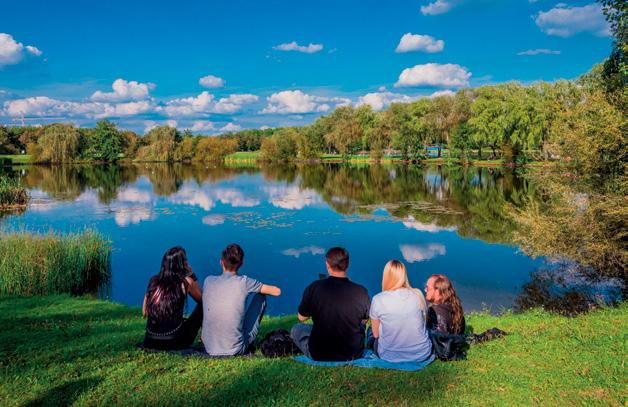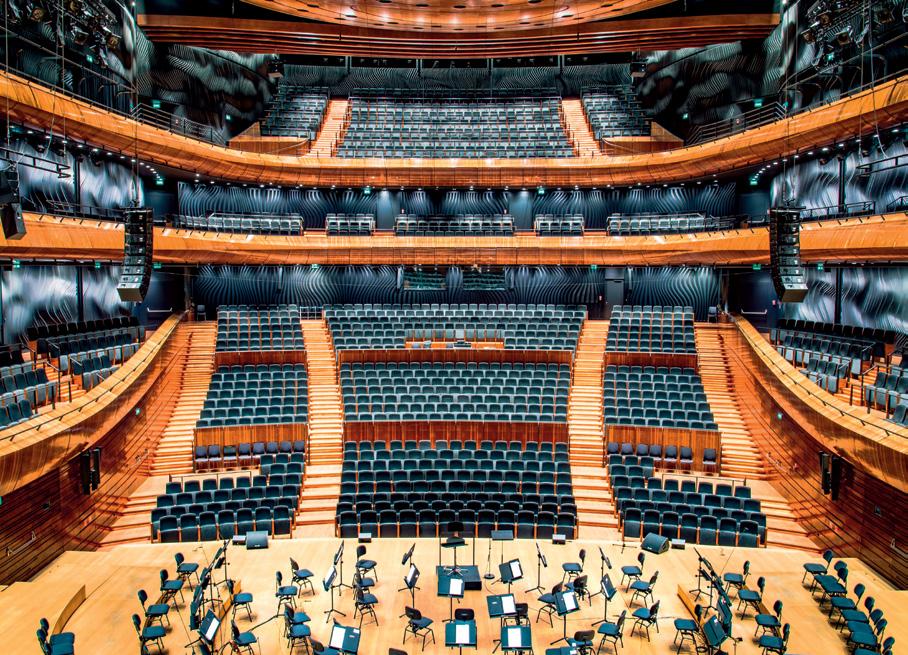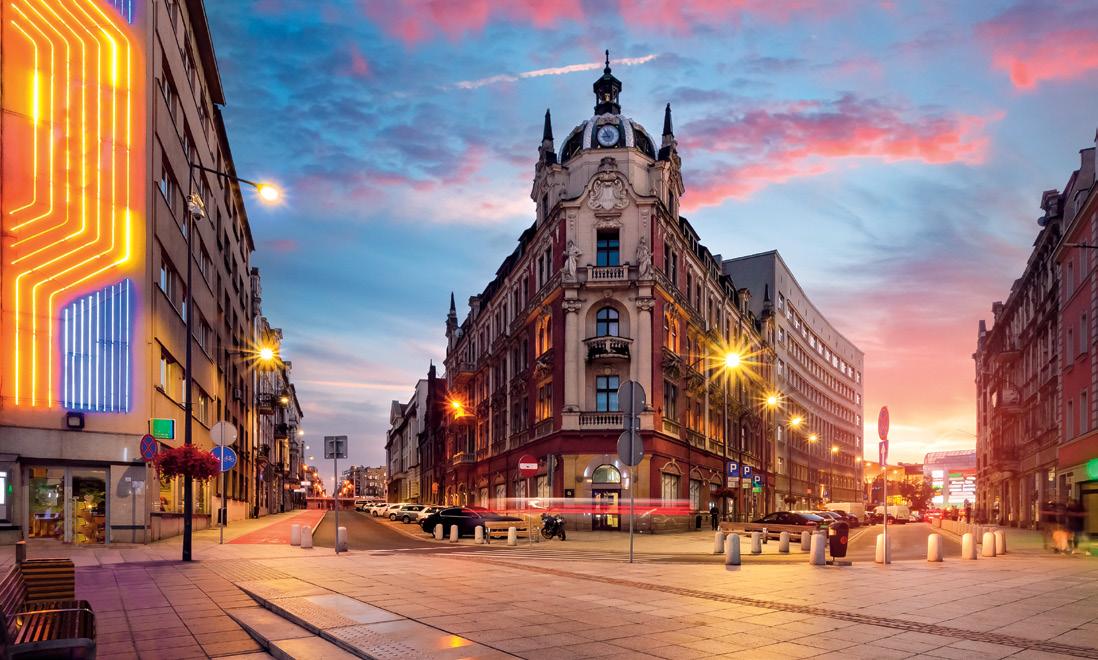
11 minute read
Polska: Katowice
koPalnia Pomysłów
A MINE OF POSSIBILITIES
Advertisement
tekst | by MAGDALeNA RUDZKA
Dla niektórych skojarzenia z Katowicami wciąż pełne są węgla, kopalnianych szybów i przemysłu. Ze mną było podobnie, ale jak się okazuje, wynika to tylko z niewiedzy. Współczesne Katowice to miasto nowoczesne, ale w stałym dialogu ze swoją industrialną przeszłością.
Some still associate Katowice with coal, mine shafts and heavy industry. Such was the case with me, but that was due to pure ignorance. Katowice is a modern city in a constant dialogue with its industrial past.
Teren Strefy Kultury ze Spodkiem i Międzynarodowe Centrum Kongresowe z zieloną trawiastą „doliną” zamiast dachu.
The area of the Culture Zone with the Spodek Arena and the International Congress Center with a green, grassy 'valley' instead of a roof.

Moje pierwsze zetknięcie z tym miastem rzeczywiście miało miejsce przy kopalnianym szybie – ale był on obiektem w supernowoczesnym Muzeum Śląskim. od razu zrozumiałam, że Katowice swoje górnicze dziedzictwo twórczo i z sukcesem przekształcają. na drugiej wizycie zupełnie wsiąkłam w zwiedzanie pięknych modernistycznych fragmentów, o których – jak się okazało – też niewiele wiedziałam. obfitość kamienic i publicznych budynków z międzywojnia wciągnęła mnie na długie godziny. takich dzielnic inne miasta mogą M PL Katowicom tylko zazdrościć. a to był dopiero początek. Miasto jest tak różnorodne, że każdy znajdzie tu coś dla siebie, a głodny wrażeń turysta nie będzie mieć problemu z zapełnieniem czasu. My first encounter with this city actually took eng place in a mine shaft - it was an exhibit in the ultra -modern Silesian Museum. I immediately understood that Katowice was creatively and successfully transforming its mining heritage. During my second visit, I was completely immersed in exploring the beautiful modernist parts of the city, which, I have to admit,
I knew very little about. The abundance of tenement houses and public buildings from the interwar period drew me in for hours. Other cities can only envy districts like these. And this was just the beginning. This city is so diverse that everyone will find something for themselves, and thrill-hungry tourists will have no problem filling in the day.
WITH MY OWN EARS
Dolina Trzech Stawów, czyli po śląsku Sztauwajery, to zielony teren niecały kilometr od centrum miasta.
The Three Ponds Valley, or Sztauwajery in Silesia, is a green area less than a kilometer from the city center. na właSne uSzy
od lat dla przyjeżdżających do stolicy Śląska, podobnie jak dla mnie, punktem charakterystycznym była wieża szybu kopalni. dziś też tak jest, jednak położony w centrum i widoczny z daleka szyb warszawa ii pełni już zupełnie inne funkcje. dostał drugie życie, stając się tarasem widokowym na kolorowe i nowoczesne Katowice. jego przemiana była elementem rewitalizacji przestrzeni po dawnej kopalni. na terenach tych powstała strefa Kultury, miejsce unikatowe w skali nie tylko Polski, ale całej europy. Powstały tu fascynujące gmachy narodowej orkiestry symfonicznej Polskiego radia, Muzeum Śląskiego i Międzynarodowego centrum Kongresowego. strefę dopełniają: spodek, czyli hala widowiskowo-sportowa nawiązująca bryłą do statku kosmicznego, oraz nowoczesny biurowiec Ktw – najwyższy budynek w województwie śląskim. aby docenić wartość strefy Kultury, nie potrzeba biletu, ale by poznać ją lepiej, warto się wybrać na konFor people coming to the capital of Upper Silesia, and I was no exception, the mine shaft tower has long been the city’s landmark. This is still the case, but the "Warszawa II" shaft, located in the city centre and visible for miles, serves a completely different function now. It has been given a new lease of life as a viewing terrace for colourful and modern Katowice. Its transformation was part of the revitalization of the former mining area. A space known as the Culture Zone has been established here. This is a unique place – not only in Poland, but in all of Europe, and undoubtedly the most impressive in the city. The fascinating buildings of the Polish National Radio Symphony Orchestra, the Silesian Museum and the International Congress Centre were built here. The area is complemented by the famous Spodek, a sports and entertainment hall resembling a spaceship, and the new KTW office building - the tallest building in the Silesian Voivodeship. You do not need a ticket to appreciate the value of the Culture Zone, but if you want to get to know it better, it is worth going to a concert at the NOSPR (the Polish National Radio Symphony Orchestra) and visiting the Silesian Museum. The red brick of the NOSPR refers to the mining district of Nikiszowiec. This state-of-the-art building houses two concert halls, the acoustics of which are considered to be one of the best in the world. The black walls of the Great Concert Hall, which can seat 1,800 people, are reminiscent of coal. The acoustics of the room was designed by the Japanese Nagata Acoustics studio. Listening to a concert at the

miasto można zwiedzać powstałym w 2020 r. szlakiem murali.
you can get to know the city by following the Murals trail, established in 2020.
Wnętrze Wielkiej Sali Koncertowej w gmachu NOSPR.
The interior of the Great Concert Hall in the NOSPR (the Polish National Radio Symphony Orchestra) building.
Katowicki Rynek, czyli jeden z głównych placów Śródmieścia, z Teatrem Śląskim im. Stanisława Wyspiańskiego.
The Market Square in Katowice with the Silesian Theatre. It's, one of the main squares in the city centre.


Nikiszowiec: osiedle robotnicze dla górników kopalni Giesche wybudowane w latach 1908–1919. Dziś to cenny zabytek wpisany na listę pomników historii.
Nikiszowiec: a workers' housing estate for the miners of the Giesche mine, built in 1908–1919. Today it is a valuable monument entered on the list of historical monuments. cert do gmachu nosPr i zwiedzić Muzeum Śląskie. czerwona cegła budynku nosPr nawiązuje do górniczej dzielnicy Katowic – nikiszowca. gmach mieści dwie sale koncertowe, których akustyka (zaprojektowana przez japońską pracownię nagata acoustics) uważana jest za jedną z najlepszych na świecie. czarne ściany wielkiej sali Koncertowej na 1,8 tys. miejsc przypominają pokłady węgla.

wIeLokuLTurowość śLąSka
Muzeum Śląskie to kompleks budynków podobnie jak nosPr powstałych na terenie dawnej kopalni Katowice. są to m.in. zrewitalizowane dawne budynki maszynowni, stolarni i łaźni. Kompleks zaprojektowała austriacka pracownia riegler riewe architekten, minimalnie ingerując w zastany krajobraz i wykorzystując do maksimum podziemną część kopalni Katowice. główny budynek ma aż trzy podziemne poziomy doświetlane przez kilka szklanych prostopadłościanów. Muzeum jako instytucja istnieje jednak (z przerwami) już od 1929 r. i niestrudzenie opowiada o intelektualnym i artystycznym dorobku i wielokulturowości Śląska. „byłą kopalnię węgla zamieniliśmy w unikatową kopalnię kultury” – to motto Muzeum. i rzeczywiście, znajdziemy tu kilka kolekcji sztuki, stałą wystawę o historii Śląska, ekspozycję scenografii teatralNOSPR is an aesthetic experience not only for the ears, but also for the eyes.
MULTICULTURAL SILESIA
The Silesian Museum is a complex of buildings erected, just like the NOSPR, on the site of the former Katowice mine. The complex includes revitalized engine room, carpentry shop, and bathhouse. It was designed by the Austrian studio Riegler Riewe Architekten, which interfered with the existing landscape as little as possible and utilised the underground part of the Katowice Mine as much as possible. The main building has 3 underground levels. Underground rooms are illuminated by several glass cuboids built on the ground. The museum, as an institution, has existed (albeit not continuously) since 1929 and has been tirelessly telling the story of the intellectual and artistic achievements, as well as the multiculturalism, of Silesia. "We have turned the former coal mine into a unique mine of culture" is the Museum’s motto. Indeed, it has several art collections, a permanent exhibition on the history of Silesia, a collection of theatre and film scenery, a library with a reading room, an auditorium, and educational rooms. In short, the Silesian Museum is Katowice's "must see".
IRON-FRAME BUILDING
Katowice owes its dynamic development, as well as its
nej i filmowej, bibliotekę z czytelnią, audytorium i sale edukacyjne.
budownIcTwo żeLazno-SzkIeLeTowe
swój dynamiczny rozwój, a także obecną pozycję Katowice zawdzięczają boomowi przemysłowemu przełomu XiX i XX w. to właśnie górny Śląsk był wtedy jedną z ważniejszych industrialnych przestrzeni na mapie europy, a Katowice szybko stały się najbardziej znaczącym ośrodkiem miejskim tego obszaru. Młode miasto (Katowice uzyskały prawa miejskie dopiero w 1865 r.) zostało przyłączone do Polski w roku 1922, stając się stolicą nowego województwa śląskiego. dla rosnącej lawinowo liczby mieszkańców powstawały nowe budynki – niektóre z nich dziś są atrakcjami szlaku Moderny Katowickiej. tworzy go 16 obiektów wybranych spośród całej zabudowy modernistycznej z lat 20. i 30. XX w. Prezentujące różnorodność funkcjonalno-użytkową międzywojennej architektury. najbardziej zaskakujący z nich to chyba tzw. drapacz chmur. na pierwszy rzut oka można by go wziąć za blok postawiony w latach 60. lub 70., tymczasem wybudowano go w 1935 r. na tamte czasy był czymś zupełnie wyjątkowym w skali europy: 14 pięter i 62 m wysokości. w 1931 r. w pobliskim kinie rialto wyświetlano film Budownictwo żelazno-szkieletowe, jego zasady i zastosowanie, którym sporo czasu poświęcono właśnie jemu. trafił też na katowickie pocztówki. tak unikatowy adres był dostępny dla nielicznych – lokatorami gmachu byli m.in. gustaw holoubek, Kalman segal i Kazimierz Kutz. present status, to the industrial boom at the turn of the 20th century. Upper Silesia was then one of the most important industrial areas in Europe, and Katowice quickly became its major urban centre. The young city (Katowice obtained city rights only in 1865) was incorporated into Poland in 1922, becoming the capital of the new Silesian Province, with its own autonomy, and the seat of the Silesian Parliament. Its rapidly increasing population required new buildings - some of which are now featured on the Modernist Architecture Trail. This attraction consists of 16 specially selected modernist buildings from the 1920s and 1930s. These buildings showcase the functional and utility diversity of interwar architecture. The most surprising is probably the "skyscraper". At first glance, it could be taken for a block of flats built in the 1960s or 1970s. Yet, it was built in 1935. At the time, there was nothing like it in Poland or anywhere else in Europe. It has 14 floors and it is 62 m tall. It attained celebrity status even before construction was completed. In 1931, in the nearby Rialto cinema, the film "Iron-Frame Construction: Its Principles and Application" was shown. A great deal of footage was devoted to this construction . It can be also found on postcards from Katowice. Such a unique

Na zwiedzenie wszystkich wystaw (stałych i czasowych) w Muzeum Śląskim trzeba przeznaczyć nawet pięć godzin.
You need up to five hours to visit all the exhibitions (permanent and temporary) at the Silesian Museum.
SzTuka uLIcy

szlak Moderny to nie jedyna ścieżka tematyczna w mieście. Można też podążać powstałym w 2020 r. szlakiem murali. wystarczy odwiedzić stronę murale.katowice.eu, by poznać lokalizację kilkudziesięciu dzieł sztuki ulicznej. ostatnie lata to też wielki powrót neonów na ulice. w latach Prl-u śmiało można było określić Katowice najjaśniej rozświetlonym polskim miastem, z niemal tysiącem neonów rozsianych po wszystkich jego dzielnicach. niektóre pokrywały prawie całe elewacje, jak na przykład ten na domu towarowym Pedant przy ul. 3 Maja. chociaż większość z nich zniknęła, są rekonstruowane i ponownie doceniane. od 2010 r. w Katowicach pojawiło się blisko sto nowych i zrekonstruowanych neonów, m.in. widowiskowy „Kot w butach”. nic dziwnego, że w końcu, w zeszłym roku, powstał też poświęcony im szlak. gdyby komuś pomysłów na Katowice było jeszcze za mało, to może wybrać się na szlak Śląskiego bluesa – tym bardziej że od ponad pięciu lat należą do sieci Miast Kreatywnych unesco jako miasto muzyki. szlak prowadzi śladami dawnych i istniejących klubów muzycznych, z których przez lata słynął Śląsk, a Katowice szczególnie. to ścieżka multimedialna – zwiedzamy ją przy pomocy aplikacji na telefon, która prowadzi po mapie miasta i umożliwia słuchanie historii opowiadanych przez muzyków o każdym oznaczonym przystanku. Podsumowując, Katowice nie tylko wyglądają, ale i brzmią dobrze. address was available to few – tenants have included Gustaw Holoubek, Kalman Segal, and Kazimierz Kutz.
STREET ART
Yet, the Modernist Architecture Trail is not the only thematic trail in the city - the authorities encourage tourists to follow different paths around Katowice. The Murals Trail, which was created in 2020, is a prime example. Go to murale.katowice.eu to find out where dozens of works of street art can be found. And if you find something that is not on the map, you can apply to have it included. Recent years have also witnessed the return of neon signs. During the communist period, Katowice could boldly be described as the Polish neon light capital and the brightest city in the country, with almost a thousand illuminated signs scattered throughout the city. Some covered almost entire elevations, such as the one on the "Pedant" department store at 3 Maja St. Although most of them have disappeared, they are being reconstructed and appreciated again. Since 2010, nearly a hundred new and reconstructed neon signs have appeared in Katowice, including the spectacular "Puss in Boots". Not surprisingly, a neon light trail was finally created last year. The "Silesian blues trail" has been part of the UNESCO Creative Cities Network as a City of Music for over 5 years. This is a multimedia trail - a phone application guides you around the city where the musicians themselves tell you about old and excisting music clubs. To sum up: Katowice not only looks but also sounds good!
Katowicki Rynek to mieszanka stylów. Na zdjęciu: neobarokowa kamienica przy ul. Pocztowej 5.
The Market Square in Katowice is a mixture of styles. In the photo: a neo-baroque tenement house at 5 Pocztowa St.
Połączenia Connections
WAW–KTW–WAW
Więcej informacji na
More information on lot.com








